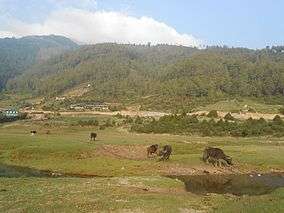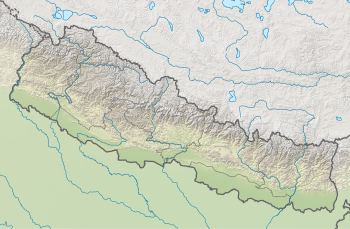Dhorpatan Hunting Reserve
Dhorpatan Hunting Reserve is the only hunting reserve in Nepal. Established in 1987 it covers an area of 1,325 km2 (512 sq mi) in the Dhaulagiri Himal of western Nepal in the Rukum, Myagdi and Baglung Districts. In altitude it ranges from 2,850 to 5,500 m (9,350 to 18,040 ft).[1][2]
| Dhorpatan Hunting Reserve | |
|---|---|
 View of Dhorpatan Hunting Reserve. | |
 | |
| Location | Nepal |
| Coordinates | 28°38′26″N 82°59′40″E |
| Area | 1,325 km2 (512 sq mi) |
| Established | 1987 |
| Governing body | Department of National Parks and Wildlife Conservation |
Flora and fauna
The landscape consists of forests, marshland (called ḍhor), and flat meadows (called pāṭan). The higher elevations remain snow-covered throughout the year. 58 vascular plants have been recorded in the reserve. Flowering plants include 36 endemic species. 18 mammal species include snow leopard, musk deer, red panda, and blue sheep. 137 bird species include koklass pheasant, cheer pheasant, and impeyan pheasant; and two reptile species also occur.[1]
gollark: ... yes, yes, ABR.
gollark: Actually, you are to use SCGI.
gollark: The Arch wiki has some information, at least?
gollark: For now, I'm hooking it up to a random online email service, but this is not optimal.
gollark: The apioforum may need to transmit email.
References
- Bhuju, U. R., Shakya, P. R., Basnet, T. B., Shrestha, S. (2007). Nepal Biodiversity Resource Book. Protected Areas, Ramsar Sites, and World Heritage Sites (PDF). Kathmandu: International Centre for Integrated Mountain Development, Ministry of Environment, Science and Technology, in cooperation with United Nations Environment Programme, Regional Office for Asia and the Pacific. ISBN 978-92-9115-033-5.CS1 maint: uses authors parameter (link)
- Wegge, P. (1979). "Aspects of the population ecology of blue sheep in Nepal". Journal of Asian Ecology (1): 10–20.
External links
This article is issued from Wikipedia. The text is licensed under Creative Commons - Attribution - Sharealike. Additional terms may apply for the media files.